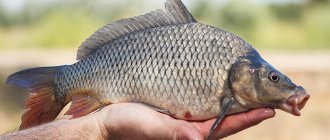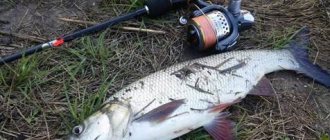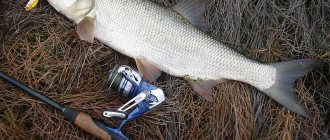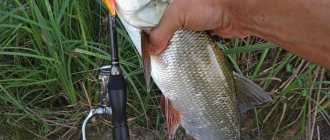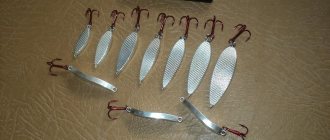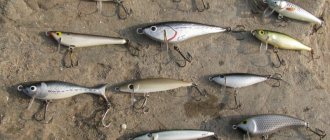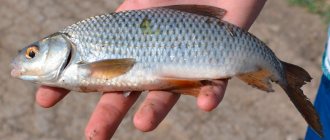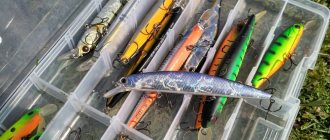Appearance and characteristics
Asp is a fish of the order Cyprinidae, the carp family. It is distinguished by the presence of many bones. The asp has a massive body, at the same time thick, shortened, and spindle-shaped. The back is wide.
The asp has a grayish color, uneven, varying from the back to the belly: the back is dark, with a gray-blue tint, the sides are silver-blue, and the belly is white. The body has large silvery scales. The front and lower fins are distinguished by a gray tint, darkening at the tips. The dorsal fin is thin, long, and sharp.
The fish has a powerful tail, the lower half of which is slightly longer than the upper. A distinctive feature is an elongated head, a large mouth, and a massive lower jaw.
These external features and lifestyle became the reason not only for the official name of the fish, but also for the appearance of other everyday names:
- Horse (mare). The fish can jump high.
- Shersper. From the obsolete verb “to bristle”, which in translation is to bristle, to be lively.
- Grab. For agility and reaction speed.
- Whiteness (whiteness). For color features: silver-grayish sides and white belly.
- Sherikh, shilishper, cherich, shereshper, zherich. Regional, distorted forms of the original name.
In the modern world, the asp is called a “river corsair”, because the fish likes the flow. Fish are found only in clean rivers rich in oxygen.
What does an asp look like?
The ease of identifying a predator is determined by its unique appearance. Common features with it are found only in chub, grass carp and ide. To distinguish the asp from other fish, it is enough to count the number of small scales in the lateral line, the number of which is 65-73 pieces. Other similar representatives of cyprinids have an order of magnitude less of them due to their larger size - ide (55-60), chub (44-46), belamur (43-45).
Other features of the sheresper’s appearance include:
- ashy dorsal and caudal fin with a dark border along the edges
- torpedo-shaped body;
- rounded back bluish-gray;
- large mouth with elongated lower jaw;
- white belly with keel;
- silvery compressed sides;
- wide gill slits;
- reddish pectoral, pelvic and anal fins. The latter has a clearly visible concave edge.
This description fully corresponds to the most common species - the European or common asp (Aspius aspius), but may differ for other generic forms. In Russia, a typical sheresper lives in large flowing reservoirs and lowland rivers of the Black, White, Caspian, Azov and Baltic seas - Don, Kuban, Northern Dvina, Volga, Curonian Lagoon, Ural, Ilmen.
Habitat and distribution
Asps are found in natural reservoirs, significantly limited to small rivers and small lakes. For full life, fish need spacious and deep water areas, where there is clean and flowing, oxygen-rich water, as well as a very impressive food supply.
Under natural conditions, such fish inhabit systems represented by large rivers, large lakes, and reservoirs of the South, Baltic and North seas of Russia.
The habitat of the asp is small, including some territories covering Eastern Europe and a significant part of Western Europe. The fish is found in parts of the Eurasian continent - between the Ural and Rhine rivers, in Central Asia: parts of Kazakhstan or the basins of the Caspian and Aral seas. There are a lot of asps on the Volga.
A small number of asp individuals are observed in the waters of Lake Balkhash, where commercial fish appeared artificially.
Asp nutrition
Juveniles eat small worms and crustaceans, adults and insect larvae. When young fish grow to 30-40 cm, they become aggressive predators and gradually specialize in eating the fry of other fish. Along the way, they happily eat beetles, large dragonflies and butterflies, their larvae and small worms. There are no full-fledged teeth on the jaws of an adult asp; there is only a bony protrusion on the powerful lower jaw and a special notch on the smaller upper lip. Therefore, when eating the fry, the asp simply swallows them and closes his jaws with a tight lock. The asp has teeth, but they are located deep in the throat and gradually grind the hard parts of its prey.
When hunting agile fry, the asp can jump above the water, spreading its fins wide. Such graceful flight is a characteristic feature of this fish. There is another special way of asp hunting for fry, for which it is often called “horse”. After its flight, the asp falls flat on top of the small victim. From this strong blow to the water surface with the tail or the whole body, a characteristic clap occurs, leading the victim into a complete stupor. Quickly at this point he grabs his stunned and disoriented victim. For this method of catching asp fry, it is often called “grabbing.” The asp is called “whiteness” or “fattening fish”, in the sense of the accumulation of fat by any animal before winter, for its gluttony.
The asp consumes protein-rich food - worms, small mollusks and crustaceans in large quantities in the wintering area, when his body is very weak. To gain strength, he does not disdain small frogs, fatty larvae and large insects. As a result, it consumes any food from the diet of all river fish and is an omnivorous inhabitant of water bodies. Therefore, in the spring, the easiest way to catch asp is with a bottom fishing rod. Expert zoologists classify the asp's diet as a group of pelagic ichthyophages that live in the upper and middle freshwater layers.
Types of asp and its features
The fish grows very quickly, gaining impressive sizes. When fishing, fishermen can boast of catch weighing 2-2.5 kilograms with a body length of 60 centimeters. Often there are fish weighing 4-5 kilograms and a length of 75-80 centimeters. But these indicators are far from the maximum. Fishermen managed to catch giant fish measuring 120 centimeters long and weighing 12 kilograms. Among the carp family, asp is a large and aggressive fish.
The average monthly water temperature directly affects not only life expectancy, but also the size of the fish. The fish is a long-liver, because the exact age has not yet been established, but it is believed that some individuals can live up to 15 years. The fish owes its vitality to its natural cowardice and reaction speed. If an individual sees an approaching shadow near the shore, it will immediately hide in the depths.

There are several varieties of asp, which are described below.
Amur flathead
The fish prefers to live at the bottom of the river. The asp has an elongated body, a low and at the same time elongated head, and a flattened forehead. A distinctive feature is the scarlet fins, due to which the Amur asp is also called the rudd. Lives in the Amur River basin: Onon, Ussuri, Shilka, Buir-Nur, Khanka, Sungari. The fish lives up to 20 years, grows up to 80 centimeters in length, gaining a weight of 2-4 kilograms.
Western Asian
This is a small fish, weighing 1.5-1.6 kilograms with a body length of 50-55 centimeters. They are distinguished by high fertility, but still the asp population is significantly reduced. The reason for this is the constant discharge of industrial waste and wastewater into the river.
Aral
The Aral asp lives in salt and fresh water bodies of Central Asia. Lives up to 9 years. It is distinguished by light smoky fins and a more squat body in comparison with the common asp. Reaches a weight of 5.5-6 kilograms with a height of 65-70 centimeters. The main feature of the Aral sheresper is the purple color of the mouth and all fins.
Spawning of asps
Sexual maturity of the sheresper usually occurs in the 3-4th year of life. In the northern regions, reproductive function develops 1-2 years later. Tributaries of rivers and slow riffles with a pebble, sandy or rocky bottom are chosen as spawning grounds. Depending on the size, the female is capable of laying from several hundred to 300 thousand large and sticky eggs with a diameter of 2 mm.
To learn more:
Top 5 best wobblers for asp
Asp spawn in pairs in April-May at a water temperature of + 10-16°C. In one narrow area, dozens of temporary “families” can be calmly and without conflicts, creating the false impression of group spawning. In search of suitable spawning grounds, marine species of sherespers are able to rise into river beds for many tens and even hundreds of kilometers. It is at this time that pairing occurs, which is accompanied by serious and bloody clashes between males. The incubation period for egg development is 2 weeks, but can be delayed for 7-10 days in cold water or bad weather conditions. At first the larvae feed on zooplankton, but as they grow they add small crustaceans, worms and insects to the diet.
Lifestyle
Asp is a fish of lowland rivers, preferring bodies of water with a current and a width of 100 meters. Reservoirs without a current are not interesting to fish, although they sometimes get caught in them. The asp is considered a predatory chaser fish, capable of plying its routes without interruption in search of food. When the asp finds a fish, he crushes it with his tail, and then swallows it. Usually, in search of food, the asp goes beyond the islands, to the riverbed areas of the reservoir, to riffles, to the mouths of flowing rivers, to large currents far from the shore.
In the first year of life, small individuals keep in packs, then they split up and go hunting alone.
What does the asp feed on?
According to the type of feeding, asps belong to the category of pelagic ichthyophages, which adhere to the upper or middle layers in the reservoir, as evidenced by the structure of the mouth and the appearance of the fish’s body. Young asps feed exclusively on worms, insects, small crustaceans and some other small invertebrates.
After the fish reaches 30-40 centimeters in length, it turns into a predator and begins to actively eat the fry of any other fish species, preferring small bream and roach. But still, some part of the diet of a growing asp still consists of worms and insects.
Due to the fact that the fish is indiscriminate, it feeds on any similar species, including weed species: bleak, ide, minnows, and even pike perch. They are prone to chasing large fish, the size of which will fit in the mouth of an asp. Often the predator grabs prey 14-15 centimeters long.
Asps are fish that chase prey rather than wait for it in ambush. In inclement weather, during heavy rains and strong winds, predators try to go deeper, sometimes rising closer to the surface to catch various small insects or beetles that actively fall into the water from vegetation hanging over the waters of the reservoir.
Spawning
Asps grow very quickly, thanks to active metabolic processes and unpretentiousness in their diet. Already by the first year of life, the body length of the average individual is about 28 centimeters with a weight of 200 grams or more.
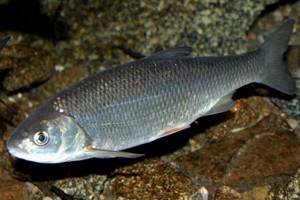
The fish reaches sexual maturity around the third year of life, when the average body weight of the asp reaches about 1.5 kilograms. The beginning of spawning directly depends on climatic conditions. In the southern territory of Russia, the spawning process begins in mid-April, lasting approximately several weeks. Reproduction occurs at a water temperature of about 7-16 degrees.
Spawning is a pair process, which is why about ten pairs of fish can spawn in one area at the same time, which creates the impression of group reproduction. The period of active reproduction of fish is accompanied by battles between males fighting for the right to own a female.
In search of spawning grounds, the asp prefers not to enter too shallow river tributaries. Selects a site on a sandy-clayey or rocky rift located in the bed of a permanently inhabited body of water. In the process of such a search, the predatory fish rises high up, even against the current.
An average-sized female is capable of laying about 50-100 thousand eggs, which settle on the roots and stems of plants that die in winter. Asp eggs have a sticky consistency and adhere very well to the substrate. After about a few weeks, under favorable conditions, the fry hatch. If the waters are not warm enough, the incubation period may last even longer.
Asp fish: description

Experts distinguish three predatory subspecies of asps. For example:
- Common or European asp, which lives on the European continent.
- Red-lipped asp, which is found in water bodies of the Middle and Southern Caspian Sea.
- Aral asp, inhabiting the Syr Darya and Amu Darya rivers.
The asp is different in that this predator does not have a stomach, and instead of it there is a straight tube with a void inside from the mouth to the tail. Therefore, food immediately enters the intestinal tract, where it is digested much faster.
This structure of internal organs is associated with rapid metabolic processes. Therefore, the asp feeds constantly, and fast metabolic processes allow him to quickly gain weight. This predator feeds not only on small fish, but also on other food items of animal origin.
Appearance

The asp can be easily distinguished from other fish species by its dark grayish-bluish back, silvery-grayish sides and white belly. The dorsal and caudal fins are colored gray, while the tips of the fins are dark, as if with a border. The lower part of the caudal fin is longer than the upper, although only slightly.
The remaining fins are distinguished by a reddish tint at the base and grayish towards the end. The asp's eyes have a characteristic yellowish tint. The body is wide, and the back area is characterized as broad and powerful. The body is covered with large and thick scales. The asp is able to jump high out of the water, spreading its fins to the sides.
The head of this predator is somewhat elongated, and the lower jaw is noticeably longer than the upper and seems to be directed upward. The asp can grow up to 1.2 meters in length, while gaining a weight of about 12.5 kg. With a weight of about 2 kg and a length of 0.6 meters, the fish becomes sexually mature, which happens around the 3rd year of life. There are no teeth on the predator's jaws, but there are peculiar tubercles and grooves, which allows the predator to grab and securely hold its prey.
Interesting to know! A common distinctive feature of all cyprinids is fleshy lips and the absence of teeth on the jaws, although the asp does not have a large number of sharp teeth in its throat.
Despite this, the asp is capable of holding and capturing even large prey, although it mainly hunts fish fry. At the same time, he first suppresses the small things (immobilizes them) and only then swallows them. This method of obtaining food does not require much effort and energy.
Trophy fishing for asp!
Behavior and lifestyle

Representatives of this class of fish inhabit lowland rivers with moderate, but not fast, currents. At the same time, the asp cannot be found in reservoirs with stagnant water, where there is a lack of oxygen. As a rule, for its hunting, the predator chooses areas of the water area behind the rifts or the mouths of small rivers that flow into larger rivers. The asp prefers to stay closer to the upper layers of water. Basically, the fish lead an isolated lifestyle and gather in small groups either before wintering or before spawning.
The predator is unique in that it has an original way of obtaining food. The asp approaches a school of fish and hits the water with its strong tail, stunning the fry. After that, he swallows the fish whole. Each adult has its own territory in which the predator hunts. Therefore, it constantly moves around the reservoir along the same route, but this does not mean at all that the asp is easy to catch if you calculate its route.
The asp begins to behave quite actively with the arrival of real warmth. During this period, fish can unite in schools and hunt in large numbers. As a rule, this happens in the spring, after wintering. In equally numerous flocks, the asp goes to wintering pits.
Interesting to know! When an asp hunts, it can be heard at a considerable distance. Fishermen say that the fish are putting up “fights”. Despite this, the asp manages to very effectively obtain food for itself.
By the “fight” of the asp, you can easily calculate its location. Of course, catching it is not so easy, but for experienced anglers this is a chance. This predator has excellent eyesight and sees everything that happens on the shore. If he notices even the slightest sign of danger, he is unlikely to take the bait.
With the arrival of autumn, the asp moves to areas with significant depth and practically does not approach the coastline. Despite this, it is the autumn period that is considered the most favorable when it comes to hunting for asp. This is due to the fact that in the fall the fish begin to store nutrients for the winter and become less cautious.
Lifespan
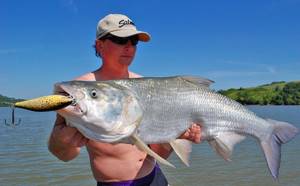
Life expectancy depends on the type of asp. It is believed that on average this predator lives about 10 years. For example, a flat-headed asp can live about 9 years, and a Western asp can live about 7 years. Nowadays, they do not have time to live up to such years, since many fishermen hunt asp and use the most advanced fishing gear for this.
Range, habitats

For the normal functioning of this predator, special living conditions are required, which today are limited to natural reservoirs that are not large in size, as well as reservoirs in which the water is polluted. The asp is a fairly large predatory fish that needs spacious and deep water areas with clean running water, rich in oxygen and rich in food supply.
In the natural environment, the asp's habitat is represented by large rivers and lakes, as well as reservoirs of the North, South and Baltic seas.
The habitat of this predator is small compared to other fish species and is limited to the territory of Eastern Europe and some part of Western Europe. You can draw a conditional line that connects part of the Eurasian continent and the Ural and Rhine rivers. The southern border of this conditional line falls on the territory of Central Asia, including part of Kazakhstan, as well as the Caspian and Aral basins. This should also include the Amu Darya and Syr Darya rivers flowing through the territory of Uzbekistan.
Interesting fact! Small populations of this predator are found in Lake Balkhash. The predatory fish was artificially introduced into this reservoir, but asp is not found in the reservoirs of the North Caucasus, Siberia and the Far East.
In the north, the habitat of the asp is limited by the Svir River, which flows into both Lake Ladoga and Lake Onega, as well as the Neva River and its water area, which flows into the Baltic Sea.
What does it eat?

The asp belongs to the category of pelagic ichthyophages, as indicated by the structure of the mouth and body of this predator; in addition, the predator adheres to the middle and upper layers of water. At a young age, the predator's diet consists of insects and worms, as well as small crustaceans and other small objects of animal origin.
When individuals grow up to 30 cm in length, they become classic predators and hunt young bream and roach. During this period, the asp continues to feed on worms and other small-sized objects of animal origin.
When an asp switches entirely to feeding on fish, he does not go overboard and hunts fry of any species of fish, including weeds, such as bleak, gudgeon, etc. The asp’s diet also includes sprat, chub, silver bream, etc. At the same time, the asp also hunts larger fish, although its size is limited by the size of its mouth. Older individuals are able to swallow fish up to 15 cm long.
Interesting to know! Asp is a predatory fish, which, compared to other types of predatory fish, searches for potential prey itself, chasing schools of fry. Moreover, such behavior for asps is typical even at a young age.
When the weather becomes inclement outside, with heavy rains and gusty winds, this predator goes into the depths. At the same time, it occasionally rises to the surface of the water, where it finds various insects caught in the water. In any case, this predator needs food. The deeper the river and the more food there is in it, the more trophy, fattened specimens are found. Naturally, in small rivers there is not enough food for the asp, so it grows slowly and does not have time to reach an impressive size.
Best biting period

Immediately after spawning (actively feeds all day).
Catching asp on a oscillator Places and wiring #OnlySpin
Reproduction process

Somewhere in the 3rd year of life, young individuals become sexually mature. At the same time, the weight of average specimens reaches one and a half kilograms. Predators inhabiting colder regions become sexually mature about 1 year later.
The spawning process begins when conditions are optimal, and this directly depends on weather conditions. Predators inhabiting the reservoirs of the southern regions go to spawn in mid-April. In this case, spawning lasts about 2 weeks. During this period, the water warms up to a temperature of 7-16 degrees. Asp spawn in pairs, and there may be several pairs in one area, which creates the illusion of group spawning.
Interesting fact! Before the spawning process, males arrange fights for the right to fertilize the eggs. Fights are not so harmless, since predators can seriously injure each other.
The asp is no different in that it goes in search of special places for spawning. It spawns in that part of the water area where it hunts. The main condition is a sandy-pebble bottom or a rocky rift. If the asp’s spawning conditions are not suitable, then he can go upstream to find a suitable place.
Each female lays from 50 to 100 thousand eggs, which stick to the roots and stems of plants that die in winter. The eggs are distinguished by the fact that they are securely held on the base. After about 2 weeks, under favorable conditions, asp fry emerge from the eggs. Under unfavorable conditions, the process of egg ripening may take a week or a little more.
Natural enemies

The asp is a rather cautious fish with excellent eyesight. At the same time, he has highly developed sense organs, so he is able to control his living space even while hunting for fry. Because of this, many predators simply do not have time to approach or even attack the asp. The same is true for humans. To catch an asp, you need to carefully camouflage yourself on the shore, then there is at least some chance of catching this predator.
Naturally, at a young age, the asp becomes an object of food for many predatory fish, as well as for waterfowl, including gulls and cormorants.
When the asp manages to reach sexual maturity, he has practically no natural enemies, with the exception of eagles and ospreys. These birds of prey are able to track an asp from a great height, after which they dive and snatch their prey from the water.
Commercial value

In addition to the fact that the asp is a cautious and timid fish, when caught on a hook, it is capable of very active resistance. In this regard, asp is of great interest for sport and amateur fishing, both in our country and abroad. This fish is especially interesting for spinning anglers who get a lot of pleasure from fishing for a predator.
It is important to know! Asp is a fairly valuable commercial fish, although its annual catch is only 0.1% of the total mass of fish caught. Asp has tasty and tender meat, and the fish quickly gains marketable weight.
Semi-anadromous varieties of asp are of particular commercial importance. Despite the excellent taste, asp meat is quite bony, so it is more suitable for drying or smoking. Asp balyk, in terms of its taste, is not much different from balyk prepared from highly valuable fish species, such as salmon, for example.
Population and species status

Small populations of asp, as well as a decrease in its number, are due to the fact that a large number of immature individuals are caught, which are caught in the nets of fishermen along with other species of fish.
The Central Asian asp belongs to the subspecies of the common asp, which is also a representative of the carp family. This subspecies is considered small in number, so it has already been included in the International Red Book. The main population of this subspecies is located in the Tigris River basin, which is in Iraq and Syria.
This predator is found in limited quantities in Karelia, where the northern border of the habitat of this fish lies. Here the fish is also listed in the Red Book. Captures of the predator do occur in this region, although they are very rare.
Various unfavorable factors should also include environmental pollution, including water bodies. In this regard, the issue of artificial breeding of asp, which is of commercial importance, is already being considered.
Seasonal fishing
In the autumn, the sheresper begins to accumulate fat for the winter and hides in the depths. At this time, large specimens are caught, but you have to fish far from the shore, which is why it is advisable to use a boat. It is not difficult to catch an active asp, but for this you use live bait or a deep-sea wobbler. The live bait must be large in size, otherwise the asp will not even pay attention to it. In autumn, aggressive fish do not allow anyone to approach them, which is why experienced fishermen camouflage themselves.
In summer
In the summer, the asp goes hunting for fry. It swims close to the shore for a short time, allowing fishermen to catch it with small baitfish. In addition to fry, frogs are used for fishing from the shore. It is not necessary to use only natural baits; it is permissible to use surface spinners and wobblers.
In the hot summer, the fish completely recovers, becomes both sensitive and timid, and does not swim to the shore. Long-range baits are used to catch predators.
The best time for fishing is considered to be early in the morning, because during this period the asp goes out hunting for schools of small fish, becoming easy prey. They look for asps in places where large schools of high-water fish move.
The asp hunts close to the surface, waiting for its prey in places with rolling water, with a strong or moderate current. Small individuals up to 2.5 kilograms begin to flock together in schools, while larger fish hunt alone.
in winter
In winter, the sheresper continues to hunt at the surface of the water, but it is difficult to catch it. This requires years of experience. The predator is caught in non-freezing reservoirs, far from the shore, in the daytime in places where bleak accumulates, when the fish are actively feeding. They catch asps using winter spinning rods. They pull out aggressive fish carefully, using a small hook, otherwise a large fish may jerk against the current, breaking the fishing rod.
They catch asps from the ice, but only in those places where potholes form in the river, there is a strong current near the pits, or the water is otherwise supplied with oxygen. To catch an asp through a hole, use:
- donka with a leash more than 20 centimeters long;
- vertical lure method using narrow spoons, castmasters or jigs;
- pike-perch silver spoons (used extremely rarely).

It is permissible to approach the potholes on ice with an ordinary spinning rod, but do not forget that there is thin ice at the edge of the water. Taking a position 10-15 meters from the ice edge will allow you to avoid falling through. In this case, you need to stop not above the current, but to the side of it.
An increase in catch will be ensured by feeding, which corresponds in composition to the seasonal preferences in the fish diet. In early spring, it is recommended to use boiled cereal with the addition of worms and bottom small animals. In May, the asp prefers only the cockchafer. In the summer, asps feed on dragonflies, pieces of fry, butterflies, grasshoppers, and large flies. Fishermen form insect balls by placing them in a feeder. In summer and autumn, it is advisable to use pieces of fish and frogs.
Fishing time and gear for asp
The sheresper is a distinct diurnal fish that retains feeding activity during the warm season. In winter, the predator prefers to stay in deep holes for a long time and feeds only occasionally in calm weather or clear days with a thaw. The best time to catch asp is morning and evening twilight from May to October. In spring and the first months of summer, fly fishing gear demonstrates good results. Artificial flies or streamers are used as bait, which imitate fry and consist of a long hook, feathers, fur, and hairs.

The lack of experience in fly fishing for sheresper can be compensated by using a spinning rod with a special floating float - bombarda (sbirulino). Here, the bait can be used as flies and streamers, as well as natural baits - a worm, a cockchafer, a cockroach, a grasshopper, a dragonfly.
Spinning for asp
For fishing from the shore, a blank about three meters long with a medium-fast action (Medium Fast) and a bait test of 5-30 g is optimal. In this regard, the Jackson Bristol Power Plus rod, which has high strength and a low working weight of 190, has proven itself to be excellent. 210 g.
To learn more:
Taimen: a valuable fish of the salmon family
Catching asp from a boat requires the use of small spinning rods (250-260 cm) with a cast of 7-50 g, which will ensure long-range and accurate casting with a short swing. These requirements are fully met by the rods of the St.Croix Legend Elite line, which, due to the correct combination of SC-VI carbon fiber and SC-V graphite, are distinguished by high load resistance, sensitivity and low weight (about 140 g). For long-range fishing for sheresper with a bombard, a composite telescopic rod Shimano Catana 330 with a length of 3.3 meters and a test load of up to 50 g is suitable.
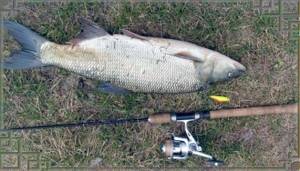
Elements of spinning tackle
The asp grabs the bait right away and immediately tries to hide in the depths. This is why it is important to use flexible blanks and a medium-sized high-speed reel (3000-4000) with a gear ratio above 5.2/1. The main monofilament line is installed with a thickness of 0.2-0.25 mm with a high tensile strength. But due to the excessive caution of the sheresper, it is better to use a thinner and more reliable braided cord. The following can be used as artificial bait for asp:
- rotating spoons – Mepps AGLIA Long HEAVY No. 3, Devon “dragonfly”, Mepps Aglia Long;
- poppers – Jackball Boil Trigger, Yo-Zuri Aile Magnet, Tiemo Calling Pepper;
- wobblers – ZipBaits Rigge 70S, Rapala Husky Jerk, Zip Baits Orbit 65 SP Slider;
- oscillating spoons – Halco Twisty, Bay De Noc Swedish Pimple, Mepps Aglia Long, Mepps Syclops.
Special attention should be paid to jigs (Renegade Iron Minnow, Kastmaster, Luhr Jensen CAST CHAMP, Sabunaev's three-edged jig), which realistically imitate the game of a fry and provide the longest, most accurate and silent casting of the bait when casting a splash, a step, against the current, or drifting in an arc. Light-colored silicone jigs, twisters and rippers also work great for sheresper, especially in cold water.
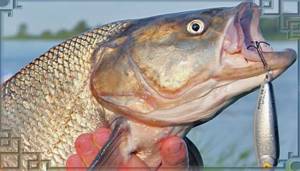
Valuable properties of asp
Asps are cautious and timid fish, at the same time violent, due to which they have gained enormous popularity in many European countries, becoming an object for spinning sport fishing. Due to the fact that asps grow very quickly, and their meat is very healthy and tasty, the fish is considered valuable.
Semi-anadromous subspecies of asp are of great commercial importance. Fish meat, despite its excellent taste, is characterized by excessive bonyness. For these reasons, it is very often used for smoking or drying, and asp balyk is comparable in taste to balyk made from salmon fish.
What dishes are prepared from asp:
- The fish meat is fatty and tender, but it contains many small bones. When salted, the bones soften and are practically unnoticeable.
- Asp meat is used for making minced meat, stewing with vegetables, in sauce and sour cream, baking in foil or frying.
- Salted asp caviar has a delicate taste. Serve as an appetizer with croutons.
- A delicious fish soup or fish soup is prepared from the fillet of the fish.
- It is very tasty to cook fish with vegetables: tomatoes, tomatoes, celery. The asp is sprinkled with herbs and baked with cheese.
- Fish meat is cooked over a fire, baked in the oven and over coals.
- Suitable for marinating and stuffing.
Methods for catching asp
The asp has no commercial significance for the fishing industry, since it rarely gathers in flocks and shoals, and also does not have any outstanding delicious taste. But among spinners, it has become a very popular catch. But many fishermen note that the methods of catching asp are troublesome and difficult. It is easiest to find it on rapids and rifts, at dams and locks. The sound of the water makes it almost invisible to the prey, and here it hunts productively. But for the asp himself, with the sound of stormy, fast-flowing water, the fisherman also becomes invisible.
The fish freezes during its hunt in small bottom depressions, and it is then that it can become the prey of a skilled fisherman. On a calm, flat river, a large asp is immediately visible; it jumps out of the water after its prey and makes noisy splashes. An experienced fisherman will not always catch asp, because he knows that it belongs to a specially protected species that is listed in the Red Book. But if he manages to catch this cautious fish, he is very proud of this difficult-to-catch prey.
You can get asp throughout the warm season. In autumn, when the water becomes cool, the asp becomes passive and goes into the depths to winter. It is better to start the asp fishing season with a float rod and so-called fly fishing tackle. Fly fishing is difficult to master, and not every angler can do it; you need good preparation and gear, a comfortable spinning rod and stopper, a bombard, a set of streamers and a strong fishing line. Fishing with a traditional float rod from a boat is more accessible, more enjoyable and easier.
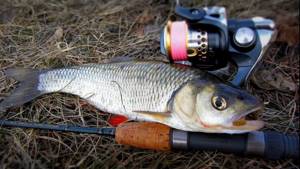
It is better to cast in places where there are massive splashes and fish hunting; the bait is also lowered downstream. Then slowly and gradually they begin to drag the line with a reel; the asp can peck even during this return movement, because he is a predator. In summer, it is better to catch asp using a regular spinning rod; it is recommended to use oscillating spoons and surface wobblers. The fish then hunt a lot and actively, fattening up for winter. In summer, it is better to use fry of other fish as bait. For hunting, it is best to use the morning and pre-sunset hours.
{banner_vnutri-kontenta-3}
Enemies of the asp
The asp has well-developed organs of vision and senses. Even during the hunt, the fish manages to clearly control the entire surrounding space, making it difficult for the asp’s natural enemies to get close to it.
Young individuals become prey for a wide variety of predators, including adult asps. The young are often eaten by some birds, especially cormorants and gulls.
Adult asps have practically no enemies in natural conditions. The greatest danger to mature specimens are eagles and ospreys. It is these birds that can spot an asp from a bird’s eye view, and then instantly swoop down and deftly snatch the predatory fish from the water.
Asp - hunter
Due to its behavioral characteristics during hunting, the asp has received several names among the people, such as horse, grip, sheresper, beles.
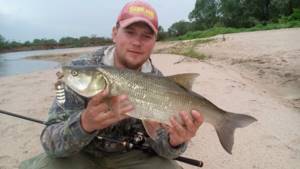
The asp is found in the upper layers of the reservoir and its hunting method is unique; it can often be detected by peculiar splashes during the hunt. Its tactic is to jump high out of the water, close to its prey, and hit the surface of the water with its tail, thus stunning the small fish and becoming easy prey.
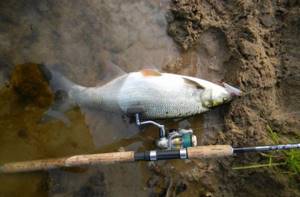
During such jumps, the asp spreads its large fins widely, which is why it is popularly nicknamed “sheresper.” The ability to jump out of the water gave it the name “horse”, and the ability to grab its prey entirely gave it the name “grab”.
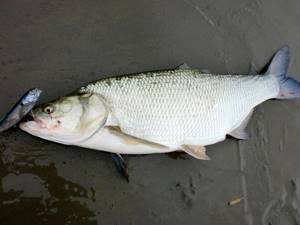
The asp does not stay in one place, waiting for prey, he is a real hunter who is actively looking for prey, being constantly on the move.
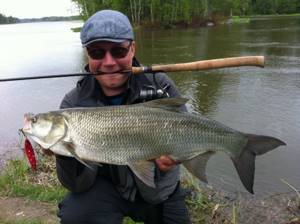
The asp is especially active in spring and summer, when these predators gather in schools, burst into schools of small fish, causing chaos there, and thus provide themselves with easy prey.
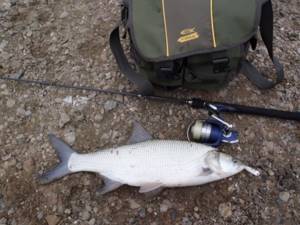
Breeding and growing asp
The asp is a representative of the carp family. It is permissible to grow fish in a pond or cage if the necessary conditions are created in which the asp will develop. Breeding is carried out both for personal consumption and for the sale of fish for the purpose of a profitable business that generates income.
Cage breeding
Asp breeding for the purpose of sale is carried out with intensive feeding of the fish. In a specially equipped pond or pool, cages made of fine mesh are organized into which asp fry are released.
Cages are bags that are attached to a floating wooden frame, additionally equipped with floats to keep it afloat. It is optimal for the cage to be 6x4 meters in size, and its height corresponds to the depth of the reservoir, but does not exceed 2.5 meters.
Fish are released into each cage at the rate of 200 fish per 1 square meter. For stocking, it is recommended to take one-year-old asps. With intensive fattening, up to 5,000 kilograms of marketable fish are obtained from one cage per season.
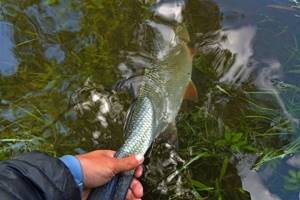
A prerequisite is the provision of high-protein food, aeration of the pond or pool, water filtration, lighting to attract natural food: zooplankton, insects.
Income is received not only from the sale of fish products, but also from the allocation of part of the area for queen cells. Next, the inseminated eggs are selected and carp juveniles are raised, which are subsequently sold for breeding on other farms.
Pond in a suburban area
Breeding asp on a summer cottage on an ongoing basis is permissible if it is possible to dig a pond or block a stream with an area of at least 30 square meters and at least 1.5 meters in depth. If such conditions do not exist, asps are bred only in summer in artificial plastic pools.
When arranging a pond, it is necessary to replicate the structure of natural reservoirs:
- Bottom soil is laid out in layers, alternating stones, clay and silt.
- They make a stepped relief with two edges.
- Aquatic plants are planted along the banks.
- There should be a hole and a shallow at the bottom.
Some part of the daylight hours must be reduced, that is, the pond must be dug in an area where there is shadow from buildings or trees. This is necessary for the fish to be able to hide in the pond from the scorching sun.
It is allowed for the reservoir to have both an artificial soil bed and a pre-concrete bed. Provided there is a natural flow of water into the pond, it is recommended to leave the natural foundation. When filling a pond with imported or tap water, a pond is made like a swimming pool with a concrete base. This will require installing a water filtration system.
The asp is released into the pond after the water has stood for about several months - this is required for the deposition of silt, the development of aquatic plants, and the creation of a certain ecosystem. With the right approach, within a few years an adult asp will begin to spawn.
The asp is an amazing fish, which, despite its timid nature, is a fast predator that does not allow itself to be eaten by stronger individuals. It is characterized by an attractive appearance, valuable and healthy meat, and is used for preparing various dishes.
0
0
Copy link
What color is the meat
The meat of Belesti, like any of the representatives of carp, is white. The fillet is quite elastic. This feature should be taken into account by those who buy grips on the market. To make sure the asp is fresh, just press on it: its shape should quickly return. When dents remain on the carcass, the purchase should be abandoned.
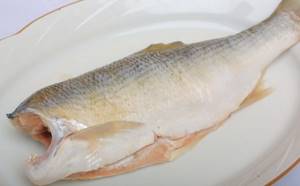
Everyone who often goes fishing knows the places and rivers where asp is found - an excellent fish that impresses not only with its tasty and healthy meat, but also with its large size. The only drawback of the grip is excessive bonyness. But experienced fishermen know how to cook it so that you can’t feel the bones in the finished dish.
Population and species status
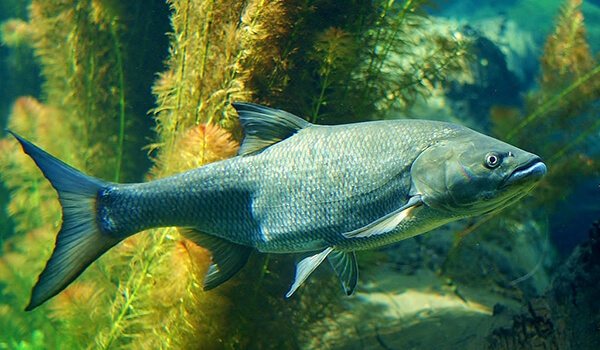
Photo: What an asp looks like
Today, the number of fish is rapidly declining in various regions of its habitat. The main reasons for this phenomenon were the catching of young individuals by nets, which were never able to survive until the breeding season, as well as the pollution of their natural habitat.
Today, such a subspecies as the Central Asian asp is the least numerous. The natural habitat of this subspecies is the Tiger River basin in countries such as Iraq and Syria.
As the population size decreases, the cost of this fish increases significantly. This contributes to the growing number of poachers. They use prohibited devices and fishing gear to hunt asp. Large feathered predators settle nearby in the habitats of the asp, which catch them in large numbers from the water during hunting, which also reduces their numbers.
Changes in climatic conditions and cooling have a negative impact on the population size. Pisces react very sharply to such phenomena. As a result of changes in water temperature, life expectancy decreases and the breeding season is delayed.

